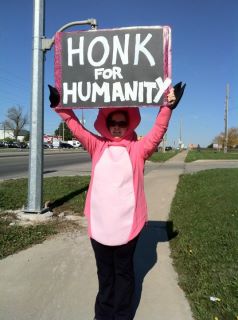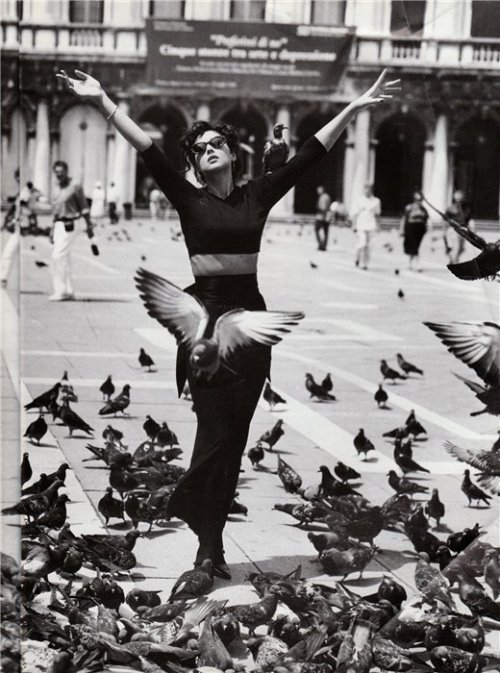An Interview with Anita Krajnc: 10 Questions For the Founder of Toronto Pig Save
Hello Everyone,
I have something very cool to share with you today.
It is an interview with the founder of Toronto Pig Save, Anita Krajnc.

- (Anita Krajnc, left)
For those of you who don’t know what Toronto Pig Save is, it is people who stand at a stoplight in protest, three times a week, as pigs crowded in those huge trucks roll into the slaughterhouse which lies straight in the heart of downtown Toronto. Around 5000 pigs a day are killed there at Quality Meat Packers. (gotta love those slaughterhouse names).
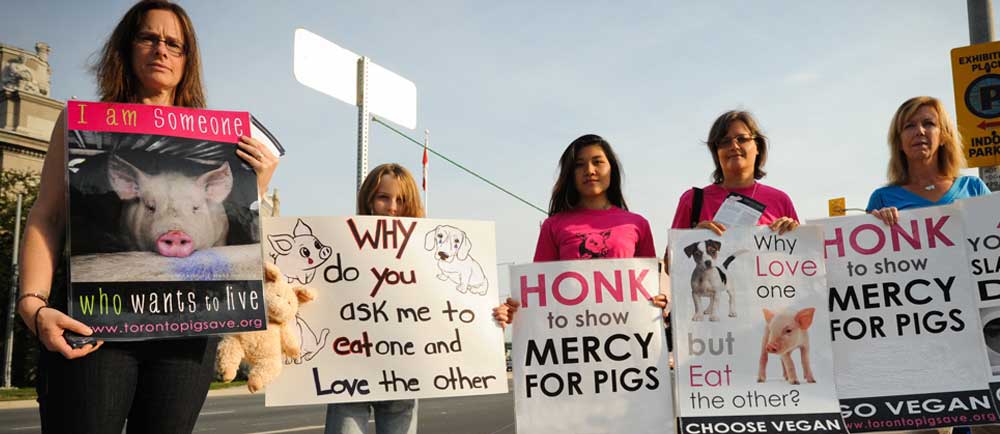
photo of Toronto Pig Save protestors from the Ghosts in Our Machine
I first learned about Anita in an Animal Voices interview I highly recommend, where she talked about (among other things) her organization’s philosophy, inspired by Tolstoy

(this guy)
of “Bearing Witness”, which basically means when you see someone suffering, fight your urge to look away and instead, go towards them and see if you can help. Or said better by Tolstoy himself as quoted below by Anita:
“When the suffering of another creature causes you to feel pain, do not submit to the initial desire to flee from the suffering one, but on the contrary, come closer, as close as you can to her who suffers, and try to help her.”
-Leo Tolstoy, A Calendar of Wisdom
Basically it is a fascinating interview you’ve got to check out. I was so inspired by how interesting and cool Anita was that I decided I had to interview her myself.
And I did.
1 Word of Caution:
What You Are About To Read And See May Disturb You
In fact, it disturbed me so much, it really changed me.
For one thing, watching the videos she sent me (linked and discussed in the interview) in which I saw Anita standing up for pigs who were freezing without protection in below freezing temperatures really touched something inside of me. It was like something I had only seen in a movie where someone, usually only at the very end, stands up for what’s right. It reminded me, standing up for animals IS what’s right, no matter what all the Bacon Lovers and PETA haters that I hear 100 times a day may say.
I also saw her footage inside the trucks of the pigs.
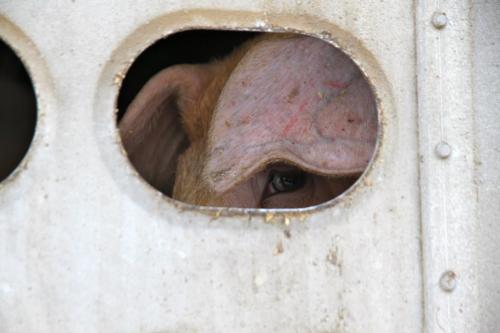
- (photo by Anita Krajnc)

Seeing that footage made me understand so much more than I ever have in 15 years of reading about animal rights. I think the problem was I had always looked away from the scenes of abuse and slaughter in graphic documentaries. Like most animal lovers, I HATE seeing videos of any sort of animal cruelty. But that’s what bearing witness is all about. This time, I was kind of like, I asked Anita so much about this whole “bearing witness” thing, I should probably watch these videos and see what it’s all about for myself.
Well…
I had always heard how intelligent pigs are, but what that means is pigs understand what’s happening to them. It is a horrible tragic experience for them, culminating in their death, and they can see it and feel it coming. You can see it very clearly in the vids that pigs are so much more like us, more human, than we realize…if we would only draw closer and look them in the eyes.
I wrote on my facebook page yesterday after seeing some of Toronto Pig Save’s videos on youtube:
When I watched these vids I had a flash of recognition…I don’t know whether I saw myself or my dogs. Their eyes convey so much, like a human eye magnified by 50. I am shaken up. In a second you see yourself in their position reflected in their eyes.
I feel more convinced than ever in my life that Veganism is no joke, not just a cool community and lifestyle, but something that deals with one of the most real, heartbreaking, evil and important issues on earth.

photo from weanimals.org by the animal rights photographer Joanne McArthur
Watching these videos reminded me of the feelings I had whenever I have read books about the Holocaust. They always talk about the cattle cars—-well, amazingly they are still in use. Pigs are so expressive, and if you watch the videos you will see, so clearly similar to us…that it changes you to “bear witness”, draw nearer, and see the reality of what it’s like for them. It makes you feel compelled to share what you know with others because your friends and family would WANT to know about this, and now I feel very different about veganism and animal rights than I did before.

photo by Jo-Anne McArthur
Though before I thought it was very likely and I was almost positive that farm animals had feelings like we did, and I agreed on principle, now I KNOW. Funny, there’s actually a big difference between being almost positive and seeing it with your own two eyes, hard as that is to do.
Like Tolstoy says, you have to FIGHT your natural inclination to look away, and “bear witness”, draw nearer, and if you do, you will be changed and you will be able to do what is right, whether that means defending animals convincingly or starting your own protest etc.
I feel now like I’m coming from a place of strength rather than uncertainty, about pigs at least.
Ok, now the interview where Anita will explain all.
Once again, I highly recommend this Animal Voices interview for some fascinating listening (it is where Anita tells all the stuff that I kind of summarized in my questions).
Without Further ADO:
10 Questions For the Founder of Toronto Pig Save
1.
Could you say a little about yourself and Toronto Pig Save, anything that comes to mind, to get us started.
Toronto Pig Save has vastly improved my life. Before TPS I often was depressed about the state of the world. Paradoxically, I know more now about the unspeakable suffering of animals, and witness it personally each week, but I also see more changes. Collective activism is the best antidote on a personal and social level.

Anita Krajnc
2.
What were you like before you started Toronto Pig Save. Were you a vegan and were you already an activist? Were you a shy and retiring type or a person who had always stood up for injustices.
In grade school, I remember writing passionately about recycling and winning a public speaking award, and then in grade 7 or 8, entering a public-speaking contest and taking an equally passionate stance against abortion! By high school, I’d changed my mind and became a feminist :) In university I did my undergraduate degree in Peace and Conflict Studies because I feared nuclear war—nothing else made sense, but to stop nuclear Armageddon. By the time I went to graduate school, there was Gorbachev using glasnost and Tolstoyan unilateral disarmament actions to melt the Cold War, so I switched course to study environmental politics.
I took a year off between my masters and doctoral studies. I remember working in Ottawa at the time as a legislative assistant to environmentalist MP Charles Caccia, and seeing the Clayoquot Sound blockade on the cover of the Globe and Mail. My sister and I decided to go to Vancouver Island for a two-week holiday and to check out the protests… but when we got to the Peace Camp, we were so impressed by the eco-feminist and mostly vegetarian camp (there was nonviolence training and a participatory consensus decision making circle) so we never left for the “hiking trip.” Instead we both got arrested on August 9th—a day of mass arrest. When I was about to be arrested, I remember starting to shake almost convulsively, I was so afraid of challenging authority. Since then, my fear has left me. In 1997 I partook in Greenpeace’s Great Bear rainforest civil disobedience action and spent only one night in jail for it—my only time in jail!
My animal rights awakening took place in the early 1990s. I saw a poster on campus advertising the screening of The Animals Film in the basement of then Sigmund Samuel library.

It was a long, graphic film. I had nightmares for three days, and then went vegetarian and became an animal rights activist for life. David Stzybel, then head of the University of Toronto Students for the Ethical Treatment of Animals (U of T SETA) had organized the screening… I am grateful to him for my initiation into the world of animal justice—he has since become a lifelong friend. I became president of U of T SETA a few years later and campaigned on getting stats on the number of animals used in experimentation (about 50,000 vertebrate per year at the time!). I was somehow clueless about the importance of veganism until around 2005, when I re-watched the film The Witness screened by an abolitionist vegan, animal rights club at Queen’s University and—finally, became vegan. I financed the purchase of 100s of copies of the film Peaceable Kingdom and distributed these to students and student clubs. I wanted to pass forward the same type of transformative film to students that had converted me in the early 1990s.
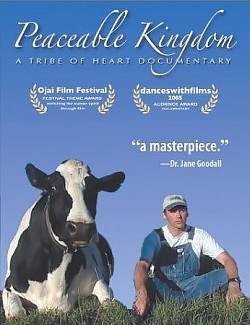
3.
In your interview with Animal Voices, you tell the story of how you got the idea for Toronto Pig Save while walking your dog downtown and coming face to face with huge trucks transporting pigs to slaughter right in the middle of your neighborhood. (I also have seen these trucks on the high way). What was it like in the moment you decided to actually do something about it. What went thorough your head, and did a plan immediately come to you?

It was liberating and it was the obvious thing to do… there was no choice at that point but to act and organize.
What I find curious and a bit scary is that I lived in the vicinity of the slaughterhouse for years, and knew some sort of activism should centre around this horror of horrors. And as I’ve just related, I had been a pretty committed activist all my life, taking on various roles in my personal and work life, and willing to sacrifice for the greater good. My training as an instructor should have equipped me to organize—I taught a course on social movement strategies and tactics at Queen’s University for three years, covering a different strategy each week, such as public education, media, community organizing, protest art, market education, NGO-government partnerships, transnational advocacy and so forth. Yet I only pondered the slaughterhouse within a kilometer of my neighbourhood a few times a year usually when I walked near the site (Quality Meat Packers is smack in the middle of downtown—a few blocks southwest of King and Bathurst). The most I did was to ask a few people if they could organize a protest, or some sort of outdoor video education display. I even asked a group all the way in Hamilton, because they were regularly leafleting and organizing direct action.
My inaction ended with Mr. Bean—a beautiful, exuberant, stubborn, and expressive (barks a lot and whines and sings) beagle whippet mix I adopted for my mom.
4.
I loved how in your Animal Voices interview, you talked about how you were inspired by Tolstoy, Gandhi, this other person (was it Ramakrishna?) and by how whenever there was any injustice in their neighborhood these great men did something about it, like when there was a famine Tolstoy would organize [a bake sale] soup kitchens. In what books did you learn about this and what did they say?
There are many books on Tolstoy, engaging in community organizing during the famine of 1891-92, especially in detailed biographies like the recent highly recommended Rosamund Bartlett (2011), Tolstoy: A Russian Life and A. N. Wilson’s (1988) Tolstoy: A Biography. Also there is an entire book about the topic: Jonas Stadling and Will Reason’s In the Land of Tolstoi: experiences of famine and misrule in Russia (originally published in 1897). Tolstoy’s family helped set up 246 soup kitchens, makeshift medical facilities, and kindergartens (most of Russia was illiterate).
This will give you a better idea… Tolstoy’s biographer A. N. Wilson (p. 400) writes:
“…it was the practical relief of human suffering which marked the next two years of the family’s life. Their example had a powerful effect, and there were many landowners, as well as sympathisers coming out from the towns, who assisted with these soup kitchens…. As well as collecting, distributing and conserving food, the Tolstoys were able to set up care for the children of the villages where they worked, and basic educational supplies. Some of the time, Sofya Andreyevna helped in their makeshift hospitals, kindergartens, and dining rooms…. She was at Yasnaya Polyana dealing with the enormous correspondence which Tolstoy’s public appeals were generating….”

people at Tolstoy’s vegetarian soup kitchen
5.
Correct me if I am wrong, but I heard you decided to start off with art activism and your website still has a lot of art on it. Why did you decide to do art first? Do you think art is a good way to do activism? I feel like this is a kind of activism I could do since I love to make art, and am feeling inspired. I have to tell you, I first heard the name Toronto Pig Save about a year before I found your interview and then facebook page through a picture on tumblr that has always stayed with me that is a picture of a burger king billboard that says No Bacon Today, All Pigs Have Been Freed by Toronto Pig Save. I couldn’t find it on your website, but I printed out a copy, and it is brilliant. I remember that photo gave me hope, and made me think, wow, why not. Why shouldn’t or couldn’t someone just save all the pigs, when before I just accepted that I could do nothing.
It’s inspiring to hear you speak of the power of art and placards and I hope you pursue your love of art for raising consciousness about animal rights. That “No bacon today. All Pigs have been freed” Photo-shopped image was made by one of our members, Al Ridley, and it appears at the end of this Pig Tribute video made by Joanne O’Keefe. (editor’s note: I recommend the whole thing)

6.
I really admire your organization’s philosophy of bearing witness and how you say you have a love based, non violent, Gandhi-an, civil rights approach to your activism. You say the experience is extremely positive and the whole community gets involved. I think that is so awesome. I struggle with this on my blog. I try to keep my blog positive and I purposefully don’t post pictures of the horrors of the way animals are treated, but at the same time I think looking at those pictures on other people’s blogs is what made me understand the truth and made me go vegan and made me passionate and committed to animal rights. But I guess I didn’t want to gaze upon my own blog and see something painful and tragic. That is a hard balance. How did you manage to bear witness but at the same time, make it a positive experience?
What we see is hard, but what’s positive is the suffering animals want us there to see them and to be their voice. If I were in that truck I would want the same. It’s made easier because we bear witness as a collective. The great artist Sue Coe said if you bear witness in a slaughterhouse by yourself, you will go insane. But collectively bearing witness is empowering and it builds community.
We also see the ripple effects of us standing there… it positively affects the public and workers in the animal exploitation industry to see us there. It sends out the message “we’re here, we care, we’re sorry and we’re trying.” We plant some seeds and puts the issue on the public agenda. Suddenly people start seeing the transport trucks and looking and talking about it at home, at school and at work. We also get media attention which takes our message far and wide and we always take pictures at every vigil and post these on Facebook and occasionally create videos of the suffering animals and us activists bearing witness for YouTube.

7.
In your animal voices interview you explain the beautiful philosophy of “bearing witness”, having a responsibility to not look away when an injustice is happening. So true. What is it like seeing the faces of the pigs and knowing you are helping them, but at the same time knowing you can’t save them…bearing witness to their suffering. I agree that it is wrong to look away when someone needs your help, but in practice, do you feel like it helps to bear witness knowing you can’t do anything for those specific pigs? And do you ever get the sense the pigs know you are on their side?
You raise a key question about philosophy and why there are such paradoxical and tragic elements to our bearing witness without helping save the individuals before us. We are there to offer brief moments of love and compassion and sympathy and our collective public protest is in the hopes of preventing other pigs going to slaughter. We say to the pigs that they did not die in vain. This is a utilitarian perspective and partly why we feel divided… guilty for not doing more because if you or I were in that truck, we would demand more. There is another philosophical perspective besides utilitarianism called a deontological approach whereby each of us does what’s absolutely right in the present. So if there is a truck full of living beings being sent to slaughter we should stop the truck and free the suffering ones… It is what Jesus, Bhudda, Tolstoy, Gandhi or King would do, and thankfully it’s what Chinese animal lovers do to free transport trucks of dogs and cats being sent to slaughter.

chinese activists who rescued a trucks of dogs bound for slaughter
The pigs definitely know who their friends are. Our vigils are 98% love-based and positive but occasionally there’s a slip as in this video called Confrontation! At the end of this video, after I’ve crossed onto slaughterhouse property and confronted managers about the freezing conditions, hypothermia and frostbite suffered by the pigs, you see the pigs coming towards me as I stand between them and the managers and act as their voice and they know.
(editor’s note: must see video)

happy pigs
8.
One amazing thing I have gathered from your interview and your website is that the truck drivers and workers at the slaughterhouses seem to be turning to your side. They take your literature and you say many of them are even vegetarians and are eating your vegan BLTS. Do you think they will end up being animal rights advocates?
A few are vegetarian… and many take our leaflets and vegan BLTs and DVDs. Our hope is that they’ll become animal rights advocates. Becka Samuels at Guelph Pig Save interviewed a former worker at Conestoga Meat Packers who now wants to join their bimonthly vigils. Our group from the start made its mission the advocacy of animal rights and worker justice. We are at the early stages of this campaign… it takes time to meet with workers and talk to them and get to know one another. We approach workers with respect as equals—but we don’t always meet this standard, especially if we view a worker who is violent with the electric prod… it is difficult remaining calm and talking in a respectful way, but it’s an ideal we strive for.
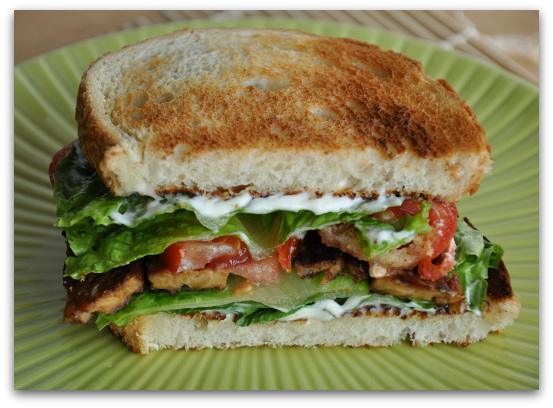
a vegan blt
There are further steps we need to take in order to set up “just transition” and healing and recovery programs for workers in the animal exploitation industry. For example, we could set up job opportunity flyers and offer help with resumés. We could promote alternative vegan jobs down the road for workers in the food industry. Vipassana classes have been offered to prisoners and soldiers (see the film “Doing time, doing Vipassana” and Dhamma Brothers on Vipassana and vegetarian meals being introduced to prisoners in a maximum security prison in Alabama). We think such healing meditation should be offered to slaughterhouse workers… These are dreams we have and ones we are working on.
9.
Did you always love animals and did you always feel a kinship with pigs? Do you know a lot about pigs now, and can you possibly say a little about your feelings about pigs and things you have learned about what pigs are like?
I have known pigs mostly in transport trucks –thousands by now since we started doing weekly vigils in July 2011) and to me they are very similar to my dog Mr. Bean, who is my best friend. They are even more expressive in their faces and their eyes, look pleading, sad, scared and confused.
I’ve met happy pigs at farm sanctuaries, including Snooters, Cedar Row, Ruby Ranch Pig Sanctuary, Teja’s, RR Horse Refuge, and Wishing Well, all in Ontario. I had the privilege of meeting Julia and her piglets at Farm Sanctuary in upstate New York during the Hoe Down. Along with the wonderful and equally exuberant Jo-Anne McArthur of www.WeAnimals.org, they starred in a short nine minute documentary I did with Humberto da Silva. See last 3 minutes of the doc.
I am about to get to know pigs much, much better, because I’m going on Big Pig Trip with Joanne O’Keefe on May 11. We are going to visit at least a dozen sanctuaries, and even take an animal communications course at Idraloka…. I’ll be video-taping and photographing pig stories and we also hope to make a stop at The Tolstoy Foundation near Woodstock Farm Sanctuary.
1. Farm Sanctuary, Watkin’s Glen, NY
3. Indraloka Farm Sanctuary, Mehoopany, PA where we’ll be taking an animal communications course
4. Poplar Spring Sanctuary ,Poolesville, MD
5. Pigs, A Sanctuary Shepherdstown, WV
6. Rikkis Refuge, Rapidan, VA
10. Home at Last
11. Ohio SPCA The Farm Sanctuary
12. Happy Trails Farm Animal Sanctuary

10.
I picked up from your Animal Voices interview, that you are a big reader. Can you suggest some of your favorite books, as I also love to read.
I love reading books, and the books I find most inspiring and also practical are books by leading community organizers including, Tolstoy, Gandhi and King. I can’t get enough of Tolstoy and recommend his 600 + works :) My favourite nonfiction book is Resurrection (his last major novel), and there is even a vegan political prisoner in it who reads Karl Marx and wears no leather. His nonfiction books are all truly foundational for the nonviolence movements of the 20th and 21st centuries. Gandhi read Confessions, The Kingdom of God is Within You, What is Art?, “The First Step” essay (on vegetarianism) and many other of Tolstoy’s books which Gandhi lists in his book Indian Swaraj. He translated many of Tolstoy’s books and essays into Gujurati and bought copies for people as must read books… It’s funny, that is something I do… I buy dozens of copies of Calendar of Wisdom by Tolstoy (which he considered his most important book) containing sayings each day from other great philosophers, and also quotes by Tolstoy himself. It is this book that contains probably the most profound and simply stated definition of bearing witness:
“When the suffering of another creature causes you to feel pain, do not submit to the initial desire to flee from the suffering one, but on the contrary, come closer, as close as you can to her who suffers, and try to help her.”
-Leo Tolstoy, A Calendar of Wisdom

tolstoy telling a story to his granchildren

A Calendar of Wisdom by Leo Tostoy
Anything else you would like to add or say, I would LOVE to hear. Please feel free, and thank you so much for answering these questions.
I would love to invite you and your readers to join one of our weekly vigils. There is nothing more powerful than bearing witness to the suffering of pigs, cows, chickens, and other farmed animals going to slaughter. It’s like being in a war zone, and witnessing the mass torture and killing of innocents. Once you see this personally, it’ll change you forever… It is strangely empowering, in the paradoxical sense that Indian prophet Ramakrishna observed:
“But my heart has grown much, much larger, and I have learnt to feel [the suffering of others].”
Once you bear witness personally, you will become a much more outspoken advocate and you’ll want everyone to see what you saw. As more and more people bear witness, major social change for animals will occur. Animal liberation will be unstoppable, and the world will be a happier place for all!
If you live elsewhere and there is a slaughterhouse in your community, please consider starting a Pig Save-like group. Check out our website for tips and please contact us. We’d love to work together with and for all our animal friends.
Thanks so much, Anita and, if you got this far, let me know any thoughts that crossed your mind in the comments section. I’d love to hear what you think about any of this stuff. I love hearing from you.
Also, Toronto Pig Save on Facebook
Talk to you in the comment section!



